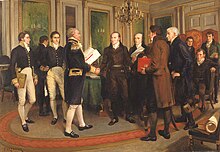Diplomatic uniform
Diplomatic uniforms were first introduced by France in 1781 and widely adopted by other European nations around 1800 in the course of administrative reforms undertaken as a response to the French Revolution and the Napoleonic Wars.
The final period during which the majority of diplomatic services retained formal uniforms for the accredited members of their overseas missions was that prior to World War II.
[3] While most countries abandoned diplomatic uniforms at some time during the 20th century, several long-established foreign services have retained them for wear by senior staff on ceremonial occasions such as the formal presentation of credentials by ambassadors.
A photo of the 2001 New Year's reception at the Vatican shows the ambassadors of Monaco, the Netherlands, Thailand, the United Kingdom, Spain, France, and Belgium all clad in diplomatic uniform.
Diplomatic uniforms generally followed 19th century court fashion and usually included a tailcoat with standing collar, breeches or pantaloons, a sword and a two-cornered plumed hat ("bicorne").
[11] Belgian diplomats of all ranks had "royal blue" tail coats and retained the 18th century fashion of white breeches and stockings with low shoes.
[14] Elaborately embroidered dress for French diplomats, counsellors of state and other high ranking civilian officials evolved during the Second Empire.
Worn for ceremonial occasions by all ranks of the diplomatic service until World War II, these richly decorated garments were retained for ambassadors only until 1960.
[15] In 1817, Prussian diplomats received as uniforms dark blue tail coats with cuffs and a standing collar of black velvet, decorated with oak leaf scrolls embroidered in gold.
In 1888, the German Empire introduced the Altbrandenburgischer Waffenrock, a long military-style coat, as the general state uniform for high-ranking officials.
[22] The standard diplomatic uniform for officials in the three primary categories of the Imperial Japanese diplomatic service (chokuninkan, sōninkan and hanninkan) consisted of a black wool frock coat with gold-embroidered paulownia flowers (chokuninkan) or buds (sōninkan and hanninkan) with gold-embroidered paulownia leaves and ornamentation in patterns and in areas of the coat corresponding to the respective category.
Diplomats who were also peers (華族, kazoku) could also wear the established uniforms corresponding to their rank, as could former or serving officers of the Imperial Japanese military.
[27] The matter of an updated uniform bearing the new national symbols not having been issued shortly following the revolution had been noticed as early as 1911, when Manuel Teixeira Gomes, the first Minister Plenipotentiary to be sent to the Court of St James's by the republican government, had to present his credentials to King George V in "evening dress with trousers".
[30] According to Bouza Serrano, there is a tradition amongst members of the Portuguese diplomatic service to keep their uniforms unaltered and not add the additional oak-leaf gold embroidery on the chest upon reaching the rank of Ambassador.
These included plain uniforms without gold braid for office wear, plus white knee breeches and stocking for court functions when royalty were present.
Peaked caps and epaulettes of military style were specified for street wear or informal occasions when the bicorn or braided tailcoat was considered unsuitable.
From 1923 to 1924, Moscow newspapers debated whether the wearing of civilian Western dress and thereby "bourgeois society symbols, which are totally alien to the spirit of the Workers' and Peasants' State" was appropriate, and there were calls for a Soviet diplomatic uniform to be introduced.
[33] The current Swedish diplomatic uniform consists of a dark blue tailcoat with gold olive-leaf embroidery on the collar, chest and cuffs with gilt buttons.
The diplomatic uniform is typically worn by Swedish officials accompanying foreign ambassadors to their presentation of credentials ceremony in Stockholm.
[38] British diplomats wore the official court uniform consisting of a dark blue button-down high-collar jacket with gold oak-leaf embroidery on the collar, chest, cuffs and long tails; white breeches were worn, or else dark blue trousers with gold stripes, and a cocked hat edged with white ostrich plumes.
Members of the Consular Service wore court uniforms with silver braiding according to rank, in contrast to the gold of diplomatic officers.
As worn by Deputy Heads of Mission, the uniform consists of a dark blue single-breasted tail coat, lined with black silk, with gilt buttons; the stand collar and gauntlet cuffs are faced with black velvet and edged with gilt braiding; this is worn with dark trousers or skirt, a bicorn hat, white gloves and a gold-mounted sword.
[43] A version for women was introduced in 2013;[40][44] previously they only had the option of a silver-gilt badge of office (the royal cypher encircled by the words "Her Majesty's Diplomatic Service") hung from a Garter-blue ribbon bow.
[45] American diplomats were first issued uniforms for the mission concluding the 1814 Treaty of Ghent; these consisted of a blue gold-embroidered coat, white breeches and stockings, a sword and a cocked hat with a black cockade.
[47] In 1853, Secretary of State William L. Marcy issued a circular recommending that U.S. diplomats wear "the simple dress of an American citizen.
In 1910, Theodore Roosevelt attracted considerable attention when he was one of the few foreign representatives at the funeral of King Edward VII who was not in civil or military uniform.
[48] In 1937, President Franklin D. Roosevelt issued an executive order directing that no person in the diplomatic or consular service should wear a uniform or official costume not previously authorized by the United States Congress.












